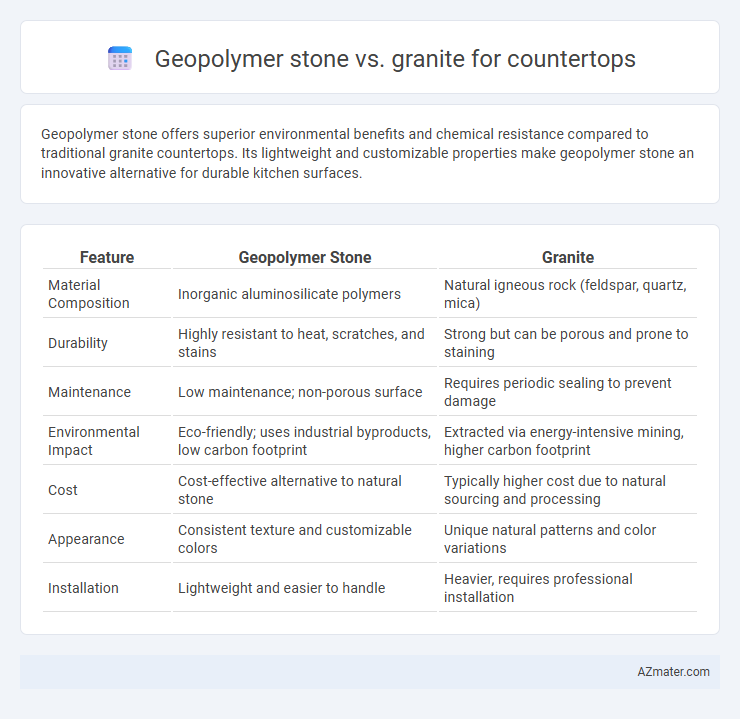Geopolymer stone offers superior environmental benefits and chemical resistance compared to traditional granite countertops. Its lightweight and customizable properties make geopolymer stone an innovative alternative for durable kitchen surfaces.
Table of Comparison
| Feature | Geopolymer Stone | Granite |
|---|---|---|
| Material Composition | Inorganic aluminosilicate polymers | Natural igneous rock (feldspar, quartz, mica) |
| Durability | Highly resistant to heat, scratches, and stains | Strong but can be porous and prone to staining |
| Maintenance | Low maintenance; non-porous surface | Requires periodic sealing to prevent damage |
| Environmental Impact | Eco-friendly; uses industrial byproducts, low carbon footprint | Extracted via energy-intensive mining, higher carbon footprint |
| Cost | Cost-effective alternative to natural stone | Typically higher cost due to natural sourcing and processing |
| Appearance | Consistent texture and customizable colors | Unique natural patterns and color variations |
| Installation | Lightweight and easier to handle | Heavier, requires professional installation |
Introduction to Geopolymer Stone and Granite
Geopolymer stone is an innovative material composed of industrial byproducts like fly ash and slag, offering high durability, heat resistance, and eco-friendly properties ideal for countertops. Granite, a natural igneous rock, is renowned for its exceptional hardness, unique veining, and long-lasting performance in kitchen surfaces. Both materials provide distinct aesthetic appeal and functional benefits, with geopolymer stone emphasizing sustainability and granite showcasing natural beauty.
Composition and Manufacturing Processes
Geopolymer stone countertops consist primarily of aluminosilicate materials activated by alkaline solutions, creating a durable, environmentally friendly composite through a low-temperature curing process. Granite countertops are natural igneous rocks composed mainly of quartz, feldspar, and mica, extracted from quarries and shaped by cutting and polishing. Unlike granite, geopolymer stones offer customizable textures and colors due to their synthetic formulation and can be produced with lower carbon footprints using industrial byproducts like fly ash or slag.
Aesthetic Options and Design Versatility
Geopolymer stone offers a wider range of aesthetic options and design versatility compared to granite, featuring customizable colors, textures, and finishes that mimic natural stone or create unique patterns. Its adaptable formulation allows for seamless integration into various design styles, from modern minimalism to rustic elegance. Granite, while prized for its natural beauty and durability, is limited to its inherent mineral patterns and colorations, restricting customization possibilities for countertops.
Durability and Strength Comparison
Geopolymer stone offers exceptional durability with high resistance to heat, scratches, and chemical stains, making it a robust choice for countertops. Granite, renowned for its natural hardness, excels in strength and can withstand heavy use without chipping or cracking, often lasting decades with minimal maintenance. Both materials provide superior durability, but geopolymer stone's engineered composition gives it enhanced uniformity and resistance to wear compared to the natural variations found in granite.
Resistance to Stains, Heat, and Scratches
Geopolymer stone offers superior resistance to stains, heat, and scratches due to its engineered composition and dense, non-porous surface, which prevents absorption and damage. Granite, a natural stone, provides excellent heat resistance and moderate scratch resistance but is more porous, making it prone to staining without proper sealing. For countertops demanding high durability and low maintenance, geopolymer stone outperforms granite in long-term resistance.
Environmental Impact and Sustainability
Geopolymer stone offers a significantly lower carbon footprint compared to granite, as it is manufactured using industrial byproducts like fly ash, reducing waste and energy consumption. Granite extraction involves extensive quarrying, leading to habitat disruption and high energy use, whereas geopolymer stone promotes sustainability through recycled materials and minimal environmental disturbance. The durability and heat resistance of geopolymer stone also ensure a long-lasting countertop solution with reduced environmental impact over its lifecycle.
Installation and Maintenance Requirements
Geopolymer stone countertops offer easier installation due to their lightweight and customizable casting process, reducing labor time compared to the heavy, rigid granite slabs that require specialized tools and professional handling. Maintenance for geopolymer stone is generally lower, as its non-porous surface resists stains and does not require regular sealing, unlike granite which demands periodic sealing to prevent moisture absorption and staining. Both materials offer durability, but geopolymer stone's simpler upkeep makes it a practical choice for homeowners seeking low-maintenance countertop solutions.
Cost Analysis: Geopolymer Stone vs Granite
Geopolymer stone offers a cost-effective alternative to granite countertops, with production costs typically 30-50% lower due to the use of industrial byproducts and less energy-intensive manufacturing processes. Granite countertops, sourced from natural quarries, involve higher extraction, transportation, and fabrication expenses, leading to significantly higher retail prices. In terms of long-term maintenance, geopolymer stone requires less sealing and upkeep, potentially reducing overall lifecycle costs compared to granite.
Longevity and Value Over Time
Geopolymer stone countertops exhibit exceptional durability, resisting scratches, stains, and heat, which contributes to their impressive longevity compared to natural granite. Granite, a natural stone with high mineral density, also offers long-lasting performance, but it requires regular sealing to maintain its resistance to moisture and staining. Over time, geopolymer stone tends to retain its appearance and structural integrity with less maintenance, providing greater value and cost-efficiency in long-term countertop investment.
Conclusion: Choosing the Right Countertop Material
Geopolymer stone offers a sustainable, lightweight, and highly customizable alternative to traditional granite countertops, with excellent durability and resistance to heat and stains. Granite remains a classic choice valued for its natural beauty, unique patterns, and long-lasting strength, though it requires periodic sealing to maintain its quality. Selecting between geopolymer stone and granite depends on priorities like environmental impact, maintenance preferences, and design flexibility for kitchen or bathroom countertops.

Infographic: Geopolymer stone vs Granite for Countertop
 azmater.com
azmater.com